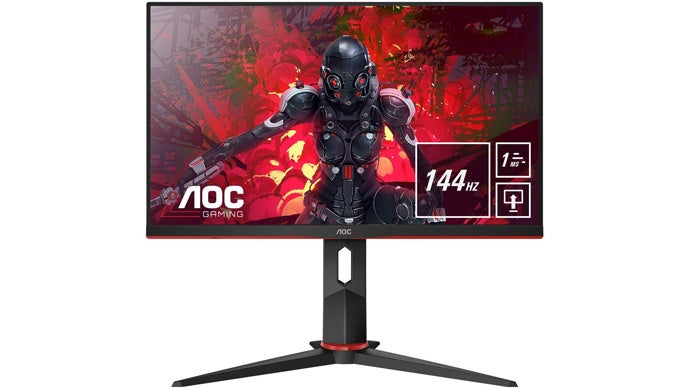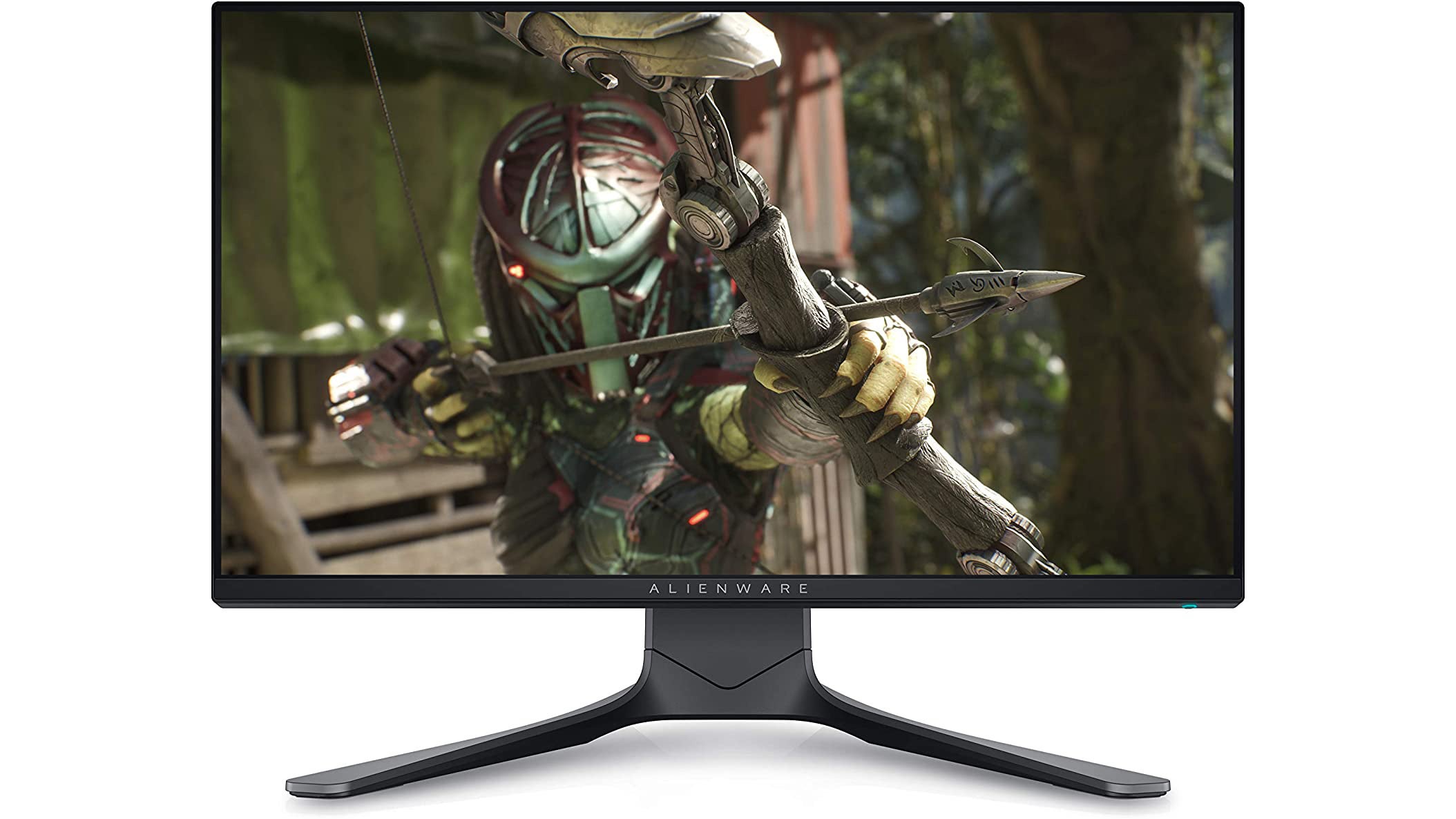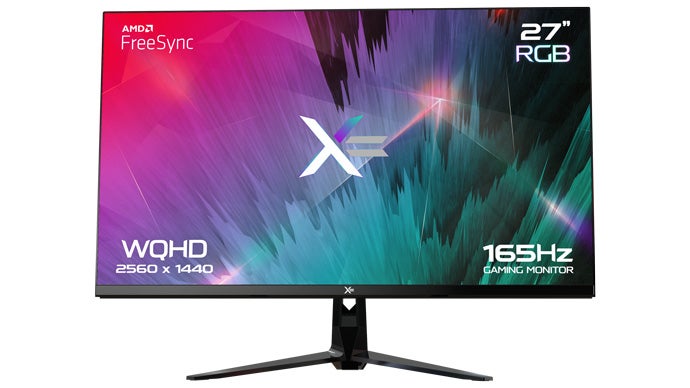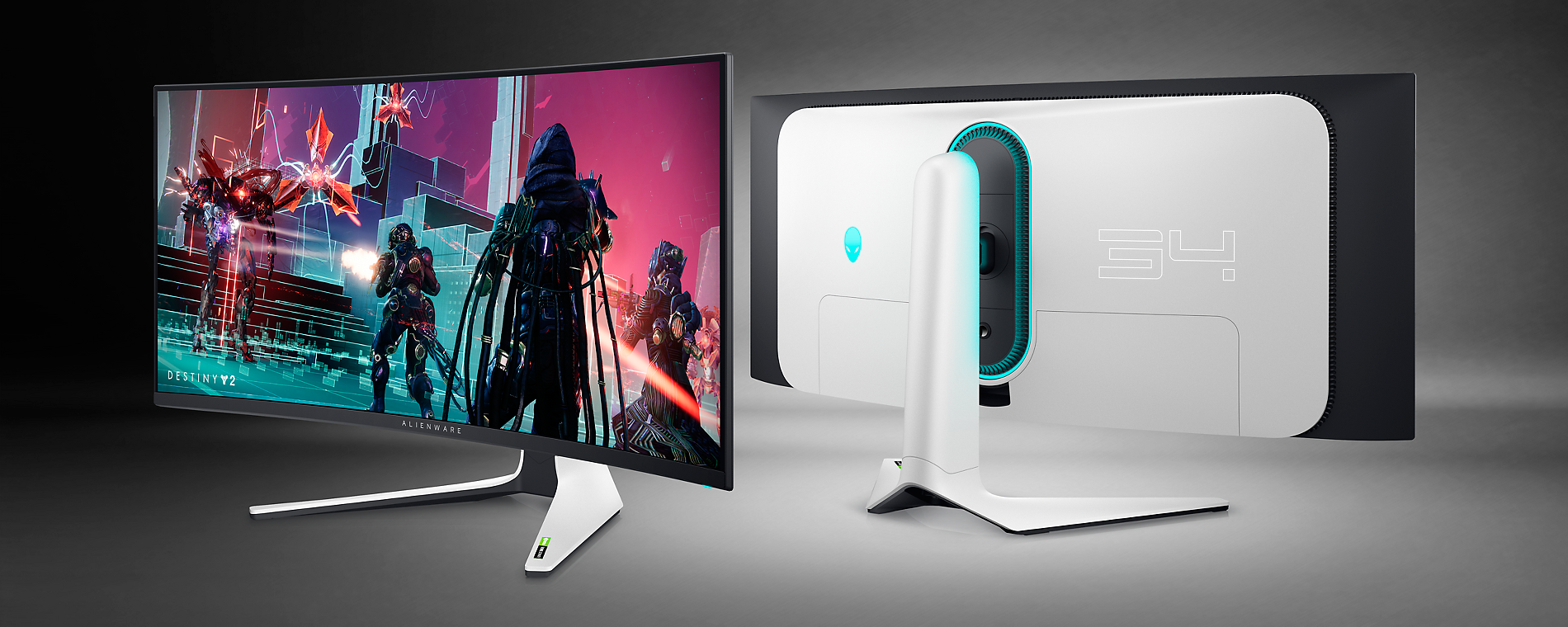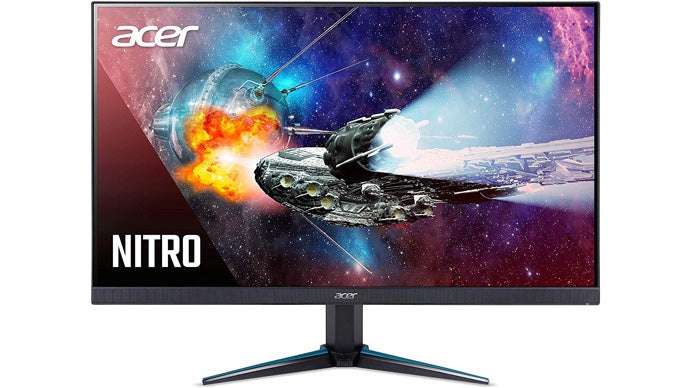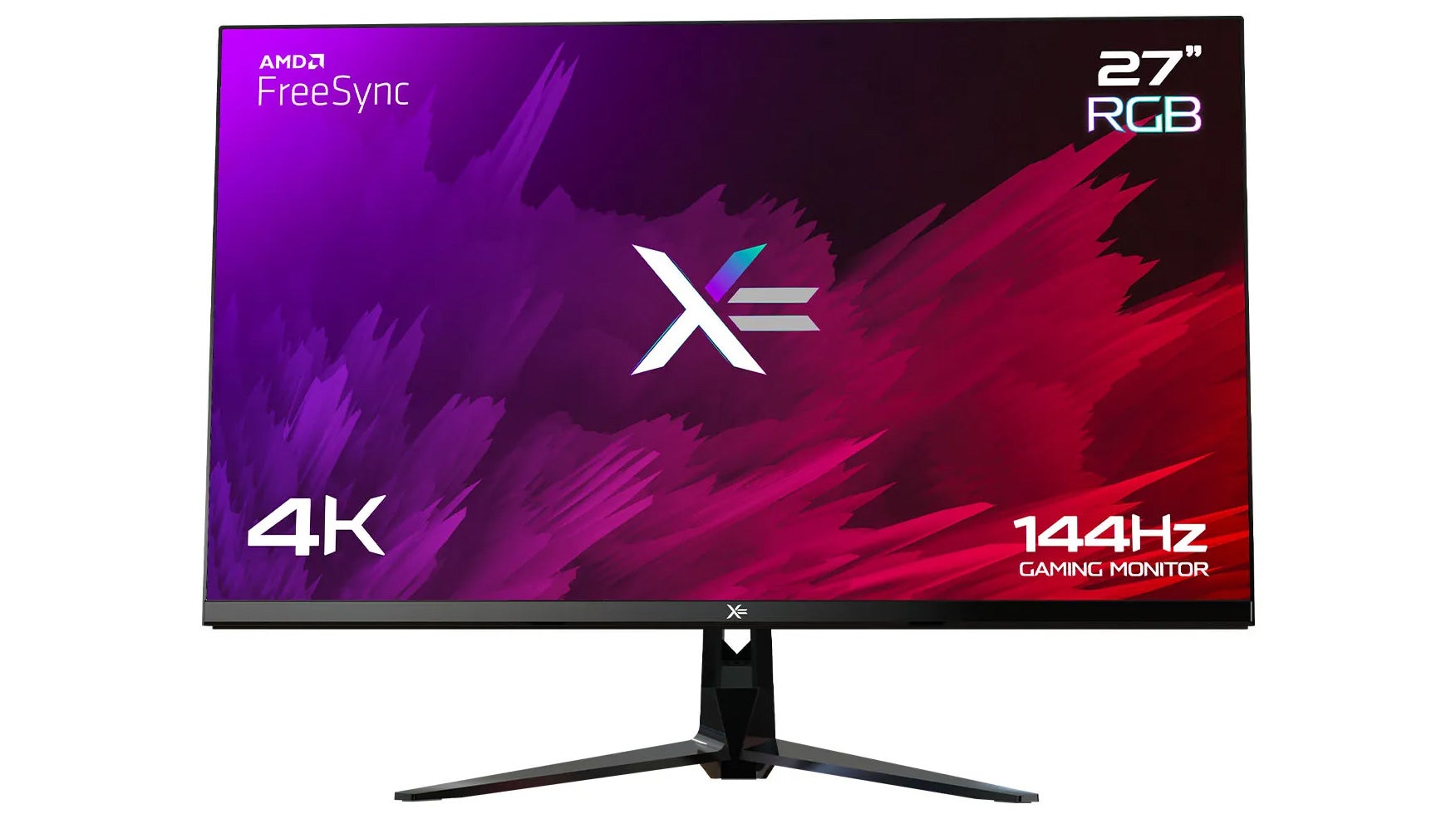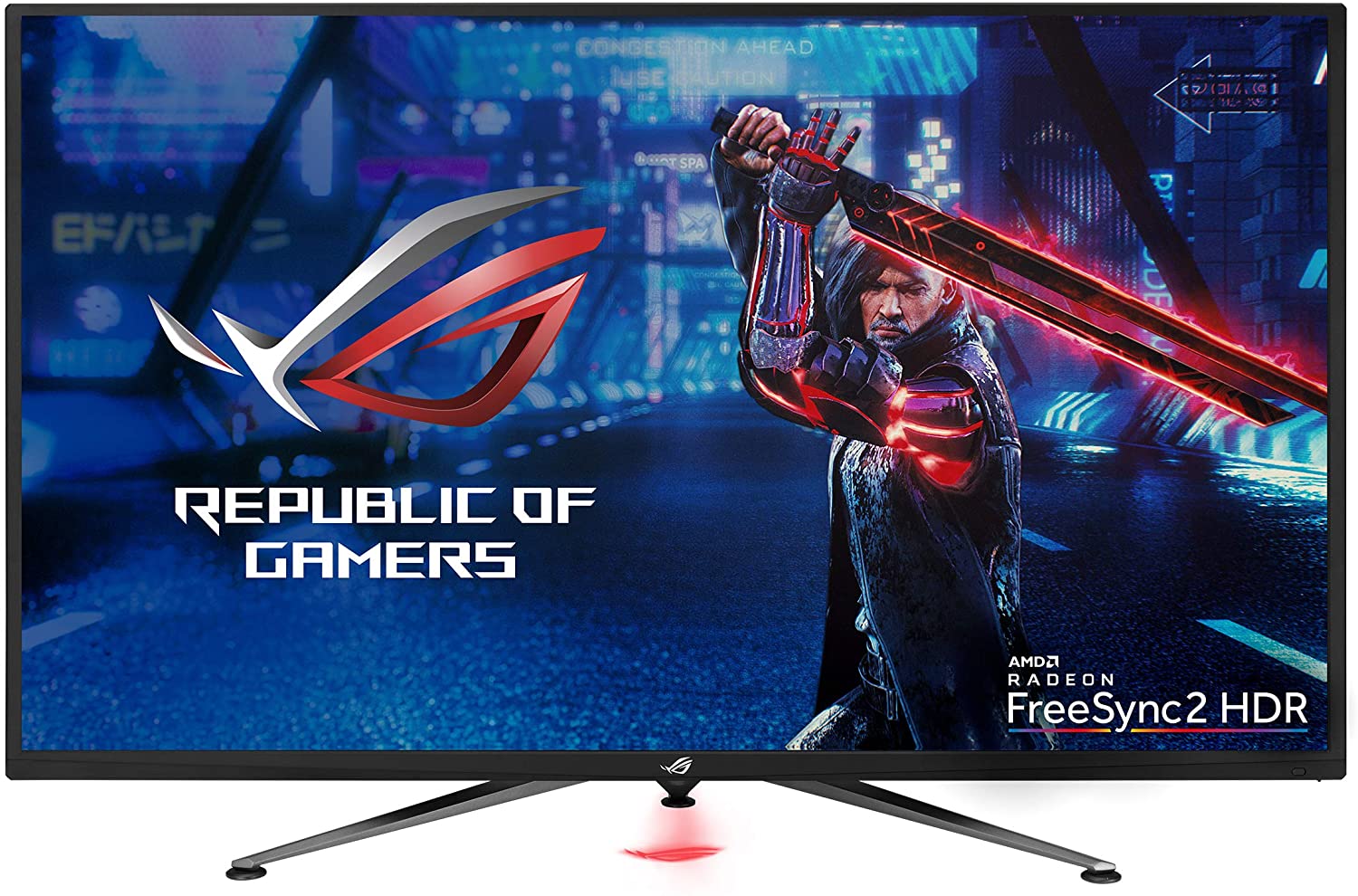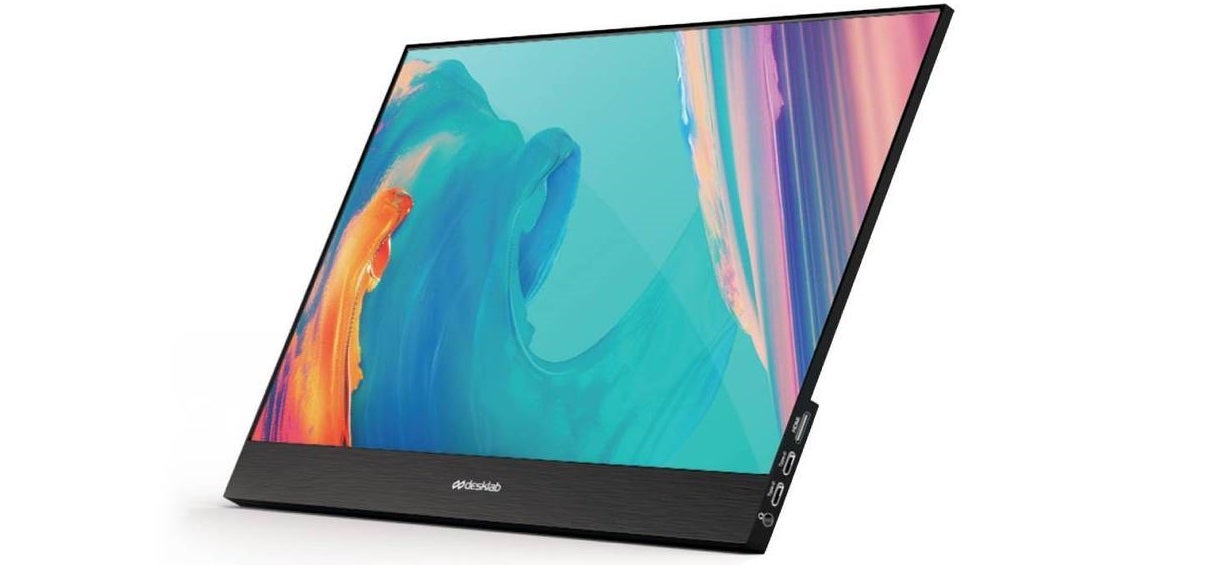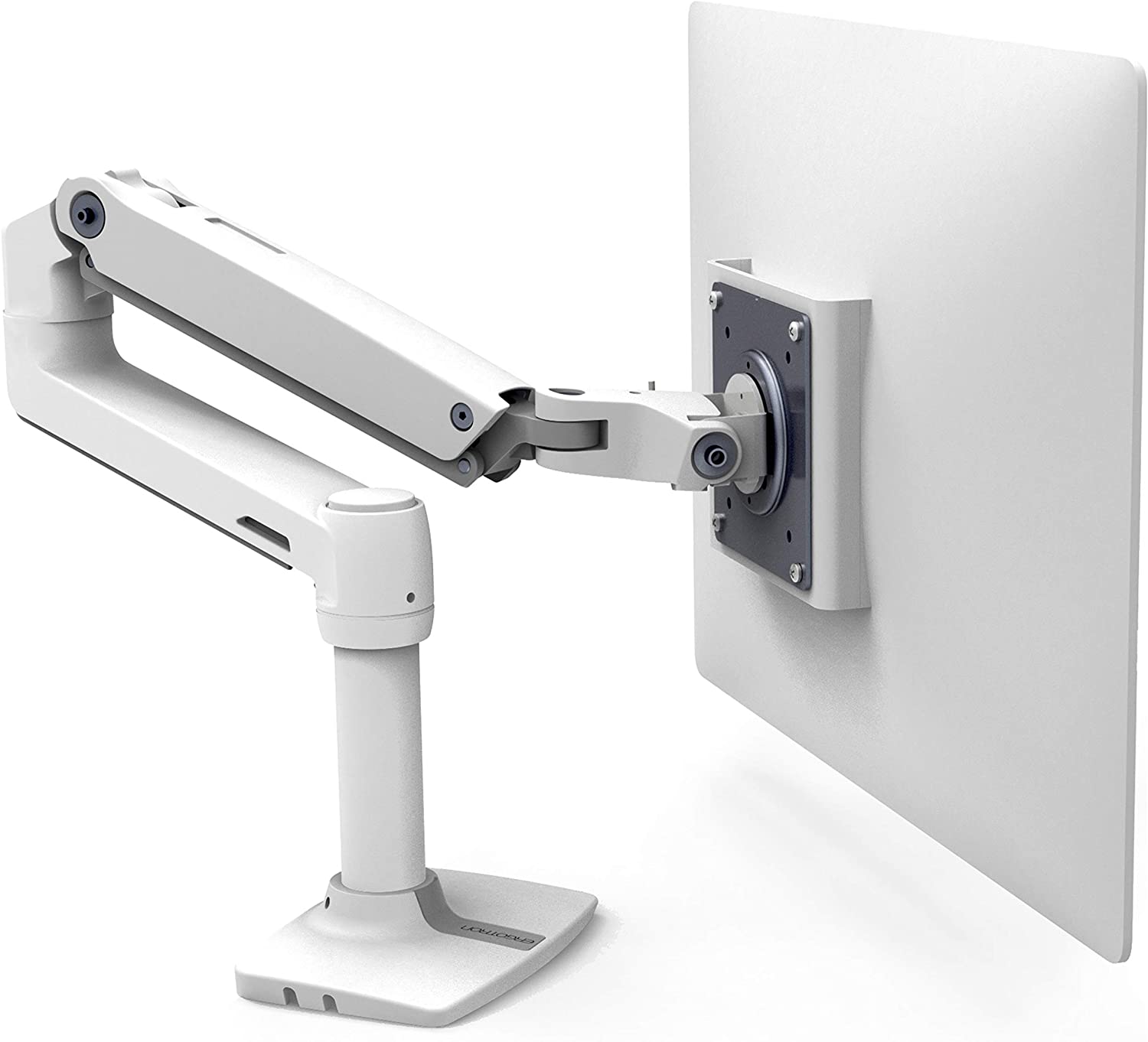That makes it important to choose the right monitor, but the options for brands, specs and features can be overwhelming. That’s why we are keeping it simple, to give you the gaming monitor recommendations you need with the bare minimum of jargon. We’ve split our picks by resolution - 1080p, 1440p and 4K. If you’re not sure which is right for you, check out our monitor buyer’s guide or just start with 1080p. For now, let’s get right into the picks! What’s the best monitor for PS5 or Xbox Series X? Our 4K 144Hz pick, the LG 27GP950, is the first HDMI 2.1 monitor to hit the market and is an excellent choice. For something larger at a similar price, check out our recommendations for the best 4K TVs for gaming.
Best cheap gaming monitor: AOC C24G2U Best 144Hz monitor: AOC 24G2U / 24G2 Best 240Hz monitor: Alienware AW2521HF
The best 1440p gaming monitors are right in the sweet spot between price and performance, offering a sharper image than 1080p models plus the option for higher refresh rates at a reasonable premium. Here are several solid choices, including ultra-wides:
Best cheap 1440p gaming monitor: X= XRGB27WQ Best 1440p gaming monitor (and our top pick overall): Dell S2721DGF Best 1440p 240Hz monitor: Aorus FI27Q-X Best value ultrawide monitor: Huawei MateView GT 34-inch Sound Edition Best premium ultrawide gaming monitor: Alienware AW3423DW QD-OLED
The best 4K gaming monitors offer the best visual fidelity, thanks to their higher pixel counts, but require a very powerful graphics card or enhanced console. Some even boast high refresh rates. Here are a series of top recommendations:
Best 4K gaming monitor: Acer Nitro VG280K Best 4K 144Hz gaming monitor: LG 27GP950 Best cheap 4K 144Hz monitor: X= XRGB27UHD Best 4K HDR gaming monitor: MSI Optix MPG321UR-QD Best TV-sized 4K gaming monitor: Asus XG438Q Best portable 4K gaming monitor: Desklab 4K
This monitor uses a curved 24-inch VA panel, providing improved colour accuracy and substantially better contrast than you’d expect from a TN monitor, which is great for games with darker scenes or playing in dark rooms. In exchange, you get slightly worse pixel response times than a TN or IPS panel. Still, combined with the fluid 165Hz refresh rate and FreeSync variable refresh rate support, you’ve got a great budget monitor ideal for PC gaming, from more cinematic fare to fast-paced titles like racing or shooters. You can use the monitor with next-gen consoles that support 120Hz output too, making it a good choice for anyone that likes to play fast-paced games on PS5 or Series X. Finally, the monitor’s stand is much better than most sub-£200 offerings, with swivel, tilt and height adjust, and there’s a USB hub with four USB ports - very useful for reducing cable clutter. Alternative options: If you’re buying a monitor for console, you might prefer the faster pixel response times of the BenQ RL2455S. This monitor uses a TN panel, making it better for fast motion, but it’s limited to 60Hz - not an issue for current-gen consoles but a bit limiting for PC users. Another option is the Acer KG251Q, has a higher 75Hz refresh rate and adds FreeSync support (40-75Hz). Ergonomics are a strong suit too, with options for tilt, swivel, rotation and height adjustment. The 24G2U also comes with FreeSync support, helping to smooth out lower frame-rates on rigs with AMD or Nvidia graphics cards. The price for this monitor is a little higher than the popular BenQ XL2411P, but the newer panel used here more than justifies the extra expense. While 27-inch 144Hz monitors are also available, often at a relatively low premium, we prefer 24-inch models for this category as they offer better value, are easier to fit into your peripheral vision and look less grainy at 1080p. Alternative options: The Samsung LC24FG73 is another strong pick, with its curved VA panel resulting in better contrast but worse viewing angles and a smaller FreeSync range. The ViewSonic XG2402 is a good choice if you prefer the fast pixel response times typical of modern TN displays. It also packs in low frame-rate compensation (LFC), which prevents tearing below the 48Hz minimum for FreeSync. Testing has also shown the XG2402 also works well with Nvidia graphics cards. These qualities make the AW2521HF well-suited to fast-paced competitive games like CSGO, Valorant or Call of Duty Warzone, while still being a great choice for slower and more cinematic games. VRR is supported too, with FreeSync for AMD and Xbox users and G-Sync Compatible for users with Nvidia graphics cards. If you’re currently playing on a 60Hz, 120Hz or 144Hz monitor, you will definitely notice the increase in responsiveness when switching to a 240Hz model like this one. The only real downsides to this monitor are its brightness (~450 nits) and contrast (~1200:1), which can make black tones appear grey, and its lack of HDR support. However, neither are big issues for competitive gaming, which is this monitor’s intended purpose, and SDR content looks just fine thanks to this monitor’s colour accuracy, gray uniformity and wide viewing angles. Alternative options: The AW2518HF offers broadly the same features as the AW2521HF, but uses a TN panel rather than IPS. This results in improved motion clarity, but viewing angles and colour reproduction are worse. If this monitor will be used for fast-paced gaming exclusively, it could be a better choice. Meanwhile, the Samsung CRG5 is a 240Hz monitor with a curved 27-inch VA panel, providing excellent contrast that improves the appearance of dark scenes. However, its viewing angles and colour accuracy are worse than the IPS AW2521HF, and its pixel response times are slower than the TN AW2518HF. It’s still a good monitor, especially for playing more cinematic single-player games that can take advantage of the high contrast ratio. The AOC C27G2ZU is another promising candidate that uses the same curved VA panel as the CRG5, but it’s available for a lower price - around £300 in the UK. There’s FreeSync and (uncertified) G-Sync support, so you’re covered on both AMD and Nvidia PCs, and there’s even rear RGB backlighting which projects a logo onto your wall - pretty neat, and easy to turn off if you don’t fancy it. HDR is supported, but with around 350 nits of peak brightness the impact of HDR will be limited. The metal stand provided with the monitor is stable enough, but takes a worrying amount of force to install and doesn’t offer any swivel or height adjustment options. Still, with 100x100 VESA support you could swap out the stand for a better desk mount down the line and end up with a very performant monitor while still saving a few bucks. In the UK, the X= XRGB27WQ is well worth considering if you’re after a good 1440p 165Hz IPS monitor on a budget. In the US, the same Innolux M270KCJ-K7B panel can be found on the Pixio PX277, which should offer near-identical performance. The combination is stunning to behold, particularly when you consider this monitor is cheaper than many of its competitors - and the same panel is used to great effect in the LG 27GL850 and LG 27GL83A (see below!) so you have plenty of options to pick one up at a fair price. Whether you prefer fast-paced multiplayer games or slower single-player experiences, you’ll get a great experience with the S2721DGF, which is why it’s our overall top gaming monitor pick overall. This monitor is also FreeSync and G-Sync Compatible, so you’ll be able to eliminate judder and screen tearing without the excessive input lag of traditional v-sync on both Nvidia and AMD graphics cards. HDR is also supported, but the relatively low 350 nit typical brightness figure means this monitor doesn’t really get bright enough to make HDR worthwhile. However, there are few monitors that do accomplish this at this price point, so that’s not a big deal. In terms of OSD options, you can expect the usual gamer fare accessed via a convenient joystick: multiple modes designed for different genres, on-screen crosshairs, automatic brightening of dark in-game areas and so on. Thin bezels, a highly adjustable stand and a wealth of connectivity options are also available. Alternatives: While the Dell S2721DGFA is our top pick, the same LG Nano IPS panel is used in several monitors including the LG 27GL850 (with USB ports), LG 27GL83A and LG 27GN850 (without USB ports). These monitors are basically identical to the Dell S2721DGF (and each other) in terms of features and performance, although the LG options are limited to 144Hz. In general, we’d recommend the Dell monitor if there’s no significant difference in price, due to that higher refresh rate, but the LG alternatives are still great performers that you’ll no doubt be happy with. The MSI MAG274QRF-QD (£499/$450) is also worth knowing about. Its quantum dot display provides excellent gaming performance, albeit with saturated colours, and it includes some unique tricks too. One is a faux-4K display mode that allows the monitor to work with the PS5, scaling down the signal to fit the 1440p screen. There’s also a USB-C connection that supports DisplayPort Alt Mode, permitting a single-cable connection for power and video for USB-C devices like laptops. Given the excellent performance here, we reckon that this monitor is worth the extra money over the Dell or LG options outlined above if you can make use of either or both of these features. This particular model uses a fast IPS screen, which offers excellent motion clarity with a quoted 0.3ms MPRT pixel response time plus the normal advantages of IPS, such as excellent colour reproduction, wide viewing angles and reasonable contrast. (You could even use this monitor for colour-accurate work during the day, then game at night!) The monitor is also FreeSync and G-Sync Compatible, so you can enjoy variable refresh rate support on PCs of all flavours, smoothing out judder and preventing screen tearing without the input lag penalty of traditional v-sync. FreeSync is also supported via HDMI for use with Xbox game consoles (Series X/S, One and One X), but you’ll only be able to use the monitor at up to 144Hz due to HDMI 2.0 limitations. Game, video and web content look great, thanks to the sharp 1440p resolution, and this pixel count is significantly easier to drive than a 4K monitor, permitting full use with only a mid-range graphics card. There are a few other features of note here. The metal stand is excellent, offering a good range of tilt, swivel and rotation, and the thin bezels make this a good choice for multi-monitor setups. The OSD is also comprehensive, with a wide range of game modes and features available, although I was disappointed to find that enabling the ‘black equalizer’ setting to lighten dark areas (to highlight hiding enemies, for example) drops the refresh rate down from 240Hz to 165Hz. In our testing, we found this monitor offered a noticeable competitive advantage over more ordinary 144Hz and 165Hz monitors, while offering a much sharper picture than 1080p 240Hz options. That’s definitely a winning formula, and therefore we’re happy to make the Aorus FI27Q-X our new top recommendation for this category. This model also comes with an integrated 10W soundbar, which is much louder and richer than the speakers built into most monitors. You can control the volume by stroking the top of the soundbar. If you haven’t invested in a separate set of speakers for your computer, this is a really nice feature, but it is one that you lose out on if you VESA-mount the monitor instead. There’s also an integrated dual microphone that is good enough to use for voice or video chat, but not quite good enough for recording voiceover. In terms of ergonomics, the stand is capable, with 110mm of height adjustment and 25 degrees of tilt; swivel and portrait rotation aren’t possible so a monitor arm might make sense here. The big draw of this monitor is its price. At the time of writing, it’s retailing for £450, less than other 3440x1440 165Hz monitors, and on Black Friday it was discounted to £380 - a great price for a well-built and performant 34-inch ultrawide. You can also pick up the version without the sound bar for £400. The motion handling is superb, making this a great monitor for fast-moving games like shooters or racing titles, while the curved 34-inch screen is suitably immersive. Playing games like Metro Exodus, where you’re exploring the desert at night, you can really appreciate the contrast available here. The monitor still gets bright enough to be used in the day, but brighter IPS or VA monitors could be a better fit for truly bright rooms. It performs best at night or in darker rooms, where its contrast reaches its lowest levels and you can really enjoy gaming or watching films. After several weeks of testing, I have to offer a strong recommendation for this monitor, but I should also mention two further quirks of the unique screen tech: the screen could suffer from burn-in, although there are plenty of countermeasures and user habits to prevent this, and the text is not as crisp as most other displays due to a different subpixel structure. Neither of these bothered me during testing, but if you’re particularly worried then you should do your own research to arrive at a conclusion. Alternative options: In the US, we’re recommending the our previous pick, the LG 27UK650-W, as the VG280K isn’t available yet. The 27UK650-W is very similar to the our main pick though, with an IPS panel that provides great colour reproduction, wide viewing angles and very low input lag. The monitor also comes with FreeSync, making it ideal for Xbox One and PC gamers with AMD or Nvidia graphics cards. Another alternative is the cheaper BenQ EL2870U, which uses a TN panel. This means its colour reproduction isn’t as strong, but its pixel response times are faster, which can be handy for faster-paced gaming. The 27GP950 outperforms other 4K 144Hz monitors at its price point with DisplayHDR 600 support, which means the screen can exceed 600 nits of brightness for HDR highlights. This standard is where HDR starts to feel more worthwhile, so it’s great to see it here. The display is also FreeSync/G-Sync Compatible, so you’ll have variable refresh rates between 48 and 160Hz to smooth out uneven frame rates and eliminate tearing/judder. A worthy alternative to the 27GP950 is the Dough (formerly Eve) Spectrum. This 4K 144Hz DisplayHDR 600 monitor offers a few unique features, such as user-configurable overdrive and black frame insertion, perfect integer scaling for retro games and 100W USB-C passthrough that lets you charge your laptop while connecting it to the monitor with a single cable. The Spectrum’s design is also great, with its optional $100 desk stand offering a classy look unmatched by most gaming monitors; if you’re planning to VESA mount your new monitor then you can skip the expense. The Spectrum is also available in a unique glossy variant for an extra $150 that produces a stunning image reminiscent that reminded me of Apple’s iMac displays and current LG OLEDs - but is more susceptible to glare. That’s a worthwhile trade-off if you largely plan to use your monitor in a dark room, especially for HDR content. You can read more about this intriguing monitor in our full Eve Spectrum review. While the screen and features are impressive, the low price does manifest in a few areas. The included stand is quite basic, lacking height adjustment, and it proved difficult to mount properly on our review unit. Thankfully, a standard 100x100 VESA mount means that it’s easy to mount on an arm. There’s RGB backlighting on the rear, which can be disabled if you wish - but a powerful status LED that fires down from the right bottom side of the monitor can only be covered by electrical tape. The OSD is also very basic, and appears near-identical to the we saw on an early version of the Eve Spectrum. Finally, the built-in speakers don’t sound great, but they are at least handy if you don’t have a headset or separate speakers nearby. Overall, it’s not a completely perfect package, but you do get some noticeable improvements over first generation 4K 144Hz panels while paying less money - so if you’re on a budget and want to live that 4K 144Hz life, this monitor is a savvy choice. The strength of the panel means this monitor brilliant at everything from gaming to HDR movie watching and content creation, although for gaming you’ll need an incredibly powerful PC with one of the best graphics cards to even get close to 4K at 144Hz in most titles - or a PS5/Series X to get 4K 120Hz. In our testing with an RTX 3080, we were able to enjoy esports titles like CS:GO at 4K 144Hz but AAA games like Metro Exodus or Call of Duty Vanguard tended to be closer to 100fps. Even if you turn down settings in some games, 4K at 32 inches still allows for crisp text on the web and detailed 4K videos, and you can get away with 100% or 125% scaling instead of the 150% you’d probably want for a 27-inch screen. I also loved the KVM feature, which together with a ridiculous number of USB ports allows you to switch a single set of peripherals from one computer to another with the press of a button - neat. At 43 inches, the Asus monitor is well suited for smaller living rooms, but also works on a desk if you’re able to sit back a bit. The large size of the screen means that you can get away with 100 or 125 per cent scaling in Windows, in comparison with smaller 4K monitors which demand 150 per cent scaling or higher, so you can really make use of the massive amount of screen real estate that 4K provides. The XG438Q uses a VA panel, which has a familiar set of strengths and weaknesses. Contrast is fantastic, rated at 4000:1, and peak brightness is a strong 600 nits, so both dark scenes and bright highlights in HDR content are well reproduced. Colour accuracy is also a strength, with 90 per cent of the DCI P3 gamut covered. That makes this monitor a reasonable choice for colour-sensitive work like video editing, with only the most modern IPS or OLED screens providing a better experience. The only real downsides to report are middling motion resolution - the quoted 4ms GtG pixel response time means fast action can sometimes appear a little blurry - and mediocre viewing angles. There’s also no HDMI 2.1 here, so next-gen consoles won’t be able to take advantage of this screen’s higher refresh rate. Even with these limitations in mind, the Asus ROG Strix XG438 remains a terrific choice - especially given that smaller monitors like the Predator X27P often cost far more! Another similar option is the Asus ROG Swift PG43UQ. This monitor costs more but has several advantages: it supports DisplayHDR 1000 and boasts a higher refresh rate of 144Hz. More importantly, it can run at 4K 144Hz with HDR using a single DisplayPort 1.4 cable. This ability comes thanks to the rare inclusion of DSC (Display Stream Compresssion), a new standard which reduces the bandwidth requirements of high resolution and high refresh rate signals without a noticeable effect on image quality. Nice one! Of course, if you want a very large monitor for playing PC or console games, modern 4K TVs are another great choice. The usual issues with input lag and connectivity have largely fallen by the wayside, particularly with the latest range of 4K 120Hz TVs that support the next-gen HDMI 2.1 standard, and you will often end up paying less for a TV than a monitor of the same size. For that reason, we recommend taking a look at our best 4K TVs for HDR gaming recommendations if you’re interested in this category! Playing Spider-Man at a café with the PS5 under the table and a tiny monitor on top was a great experience, and using the Desklab 4K as a second monitor also worked well. This is actually a touchscreen monitor as well, so you can even use it with phones or Windows laptops to play touchscreen games or just quickly reach out to push a button on-screen. The pixel response times and contrast of the monitor were surprisingly decent, while brightness at its highest setting (400 nits) was enough to make it easily visible even when opposite an open window (albeit on an overcast winter day). Colours and viewing angles were up to snuff too, as you’d hope from an IPS panel, and even HDR is technically supported (although the screen doesn’t get bright enough to make it impactful). The built-in speakers get comfortably loud without distortion, despite the Desklab 4K’s slim design. The only criticism I have is that the monitor’s essential stand/cover is sold separately for $50, and I don’t see the Desklab 4K being usable without it. Still, if this premium monitor is in your budget, then it feels like you at least get a lot for your money. Generally, fast-paced and competitive games like shooters, real-time strategy or racing games will benefit from higher refresh rate monitors, while slower-paced games like role-playing games and turn-based strategy games are best played on a higher-resolution monitor. Resolution is normally given as the number of horizontal pixels (eg 1080p, 1440p), while refresh rates are given in Hz and correspond to how many times per second the screen is redrawn (eg 60Hz, 144Hz). For example, the standard specification for entry-level monitors is 1080p 60Hz (a 1920 pixel wide and 1080 pixel tall screen that updates 60 times per second). Meanwhile, the current gaming monitor sweet spot between price and performance is 1440p 144Hz (a 2560x1440 screen that updates 144 times a second). To learn more, read our guide to essential monitor terms here. If you’re not sure what resolution and refresh rate to choose, a good starting point is to identify the strength of the graphics card inside your PC using our GPU power ladder. In broad strokes, an entry-level PC will be best used with a 1080p 60Hz monitor, while a mid-range PC can stretch to a higher resolution (1440p), a higher refresh rate (144Hz) or both. Finally, high-end PCs are a good fit for 4K. Bear in mind that the real situation is more complicated than this, as some games are more demanding to run than others and it’s often possible to turn down graphical fidelity settings in exchange for a higher frame-rate. The current sweet spot between price and performance are monitors with a 1440p resolution and 144Hz refresh rate. In slower paced games and content creation, you’ll appreciate the extra visual fidelity and screen real estate, while in faster esports titles the higher refresh rate will make hitting flicks or skill shots easier. That’s why we’ve selected a monitor that fits this specification as the best gaming monitor overall. Of course, there are plenty of alternatives too! For consoles, things are a little simpler. HDMI 2.1 monitors support 4K resolution up to 120Hz, matching the highest possible output of the Xbox Series X and PS5, and are finally available at reasonable prices. If you’re operating on a more limited budget, then a 4K 60Hz monitor (for slower games) or 1080p 120Hz monitor (for competitive games) are good bets too. Resolution: How many pixels are on screen, given as horizontal x vertical. 1920x1080 (1080p) and 3840x2160 (4K) are the most common resolutions for both TVs and monitors. The higher the resolution, the crisper and more detailed a game tends to look. Refresh rate: How many times the screen updates per second, given in Hz. Standard monitors and TVs refresh at 60Hz, while gaming models may refresh anywhere from 100 to 240Hz, with 144Hz being the most common choice for a high refresh rate monitor. The higher the refresh rate, the more fluid a game will feel. Response time: This stat typically measures how fast a pixel can turn from grey to white and then back to grey again. Most gaming monitors sport response time figures of less than 5ms, with TN panels being the fastest and IPS or VA screens being a little slower. Low response times help to eliminate distracting smears in fast-paced scenes. Note that response time is distinct from input lag, which refers to the delay between an input (like pressing a button) and seeing the effect of the input on-screen. Contrast ratio: Simply the ratio between the brightness of a display when it is displaying perfect black versus perfect white. Around 1000:1 is typical for an IPS display, a VA display can hit 3000:1 or higher and an OLED has technically infinite contrast, as its organic LEDs can switch off entirely to create a completely dark image. High contrast ratio screens look particularly good in dark rooms, as blacks will appear properly black rather than dark grey. When a high contrast display also has high peak brightness levels (eg 600 nits and up), HDR content will look punchier too. G-Sync/FreeSync: These are both terms that refer to adaptive sync technology, designed to eliminate ugly screen-tearing while adding less input lag than traditional v-sync. G-Sync is Nvidia’s implementation, which normally requires a physical G-Sync module inside the monitor that can drive up prices. FreeSync is the AMD alternative, which doesn’t require a special module and therefore doesn’t add much to a monitor’s price. Recently though, Nvidia announced support for FreeSync displays on GeForce graphics cards, although adaptive sync performance may vary significantly from monitor to monitor. G-Sync requires a Nvidia graphics card to work, while FreeSync requires an AMD card. HDR: High Dynamic Range allows for greater contrast between the lightest and darkest parts of an image, as well as a wider colour gamut. While a growing number of monitors are technically HDR-capable, most can’t hit the high peak brightness figures that actually make the feature worthwhile. We recommend sticking with monitors that hit stringent standards, like HDR10, if playing games or watching films in HDR is important to you. IPS: This sort of monitors tend to be expensive to produce, but provide better viewing angles and improved colour accuracy compared to monitors using VA or TN panels. However, some IPS panels, particularly older ones, can suffer from slower response times, making them worse for fast-paced games. Another potential issue is ‘IPS glow’, where the monitor’s backlight is visible in dark scenes. Nano IPS monitors tend ot offer TN: The most mature display technology, TN panels are cheap to produce and offer some of the fastest response times. However, colour accuracy and viewing angles tend to be poor, sometimes resulting in a washed out look - particularly if you’re not viewing the monitor head-on. However, modern TN panels do well to minimise these drawbacks. VA: A type of monitor panel which tends to occupy a middle-ground between IPS and TN in many respects. These panels generally offer the best contrast, backed with good response times and colour reproduction.

